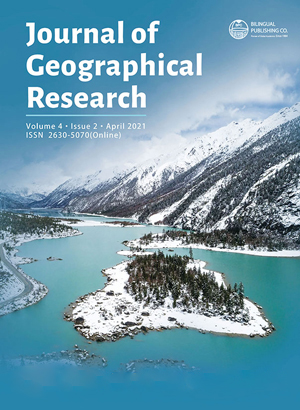-
1445
-
372
-
303
-
233
-
195
Analyzing Urban Expansion and Spatial Growth Patterns in Barahathawa Municipality of Central Tarai Region, Nepal
DOI:
https://doi.org/10.30564/jgr.v4i2.3024Abstract
The rapid transformation of rural settlements into municipalities in Nepal has brought significant changes in land use, and urban expansion and growth patterns mostly through the conversion of agricultural land into the built-up area. The issue is studied taking a case of the rapidly growing town, Barahathawa Municipality of Tarai Region of Sarlahi District. After the declaration of the municipality, several new roads have been opened and upgraded; and the municipality is well-connected to the national transportation network. After promulgated the Constitution of Nepal 2015 and functioning the elected local body, the municipality budget has been increased significantly as a result of increasing municipal investment in socio-economic and physical infrastructure development and environmental protection which has attracted people, goods, and services creating the zone of influence on the municipality. One of the changes found in the municipality is the increasing built-up area and expansion of urban growth through the decreasing agricultural land. Urban growth has been observed taking place around the Barahathawa Bazaar and main roadsides. The built-up area in Barahathawa municipality has remarkably increased by 183percent with the decrease of shrub and agricultural land within 10 years. Implications of such spatial and temporal dynamics have been a core issue of urban planning in most of the newly declared municipalities in Nepal.
Keywords:
Land use; Urban expansion; Municipality; Built-up area; Spatial planningReferences
[1] Sharma, R.P. (2012). Urbanization, Planning and Development: Consequences, Opportunities and Future. SAMBRIDHI, a Development Journal of Center of Development Studies.https://www.academia.edu/2029224/Urbanization_Planning_and_Development_ConsequencesOpportunities_and_Future9. Accessed August 25, 2020.
[2] Devkota, K. (2018). Challenges of Inclusive Urbanization in the face of Political Transition in Nepal.In Joshua, Mugambwa & Mesharch, W. Katusiimeh (eds.), Handbook of Research on Urban Governance and Management in the Developing World. USA: IGI Global.http://www.Sias-southasia.org.
[3] Maheshwari, B. Singh, Vijay P. & Thoradeniya, B.(2016). Balanced Urban Development: Is it a Myth or Reality? In Basant Maheshwari, Vijaya P. Singh & Bhadranie Thoradeniya (eds.), Balanced Urban Development: Options and Strategies for Liveable Cities. Springer Open.https://link.springer.com/content/pdf/10.1007percent2F978-3-319-28112-4.pdf.
[4] Kleemann, et al. (2017). Peri-urban land use pattern and its relation to land use planning in Ghana,West Africa. Landscape and Urban Planning, 165, 280-294. ELSEVIER.https://www.elsevier.com/locate/landurbplan.
[5] Markus et.al. (2018). Urban expansion in Zanzibar City, Tanzania: Analyzing quantity, spatial patterns and effects of alternative planning approaches. Land Use Policy, 2018 – Elsevier.https://doi.org/10.1016/j.landusepol.2017.11.007
[6] Alexandar,J.N. (1954). The Basic-Nonbasic Concepts of Urban Economic Functions. Economic Geography, 30(3), 246-261.DOI: https://doi.org/10.2307/141870.
[7] Shrestha, C.B., & Rijal, S.P. (2015). Revisit to Functional Classification of Towns in Nepal. The Geographical Journal of Nepal, 10,15-27. Kirtipur. Central Department of Geography, Tribhuvan University.
[8] Alber, R., Adams, J.S. &Gould, P. (1971). Spatial Organization; The Geographer’s View of the World.Englewood Cliffs, N.J.: Prentice-Hall.
[9] Mayer,H.M. & Kohn, C.F. (1959). The Economic Base of Cities. In H.M. Mayer and C.F. Kohn (eds.),Readings in Urban Geography, Chicago: Chicago University Press.
[10] Timalsina, K.P. (2011). Struggling for Livelihood:Making a Living in the Urban Informal Sector.VDM Verlag Dr. Müller, Germany.
[11] World Bank. (2013). Urban Growth and Spatial Transition in Nepal, An Initial Assessment.Washington DC, The World Bank.
[12] Dahal, K, (2007). Urban Studies: Concepts and Theories of Urban Development and Planning.Pairabi Publication.Kathmandu.
[13] ICIMOD.(2010). http://rds.icimod.org/Home/DataDetail?metadataId=9224, Accessed on 12/08/2019.
[14] Barahathawa Municipality. (2018). Municipality Profile. Barahathawa Municipality.
[15] CBS. (2011). National Population and Housing Census (Village Development Committee and Municipality). Central Bureau of Statistics, Government of Nepal, Kathmandu.
[16] DUDBC. (2018). Preparation of Integrated Urban Development Plan Barahathawa Municipality.DUDBC, Kathmandu.
[17] Government of Nepal (2019). Nepal Gazzet (Rajpatra). August 23, 2019. Singadarbar,Kathmandu.
[18] Ministry of Land Reform and Management (MoLRM). (2015). Land Use Policy 2015.Kathmandu,MoLRM.
Downloads
How to Cite
Issue
Article Type
License
Copyright © 2021 Kedar Dahal, Krishna P. Timilsina

This is an open access article under the Creative Commons Attribution-NonCommercial 4.0 International (CC BY-NC 4.0) License.




 Kedar Dahal
Kedar Dahal





